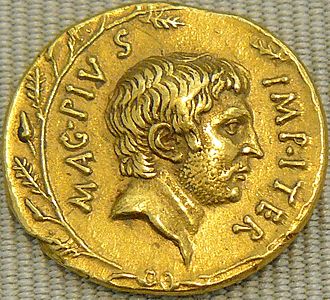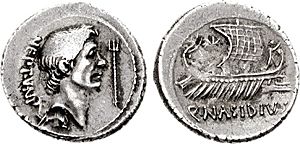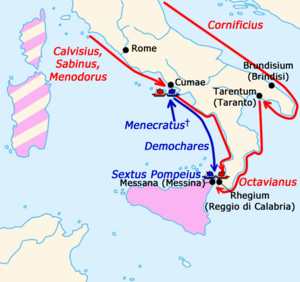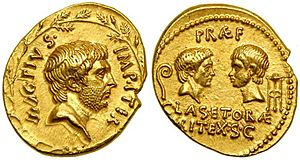Sextus Pompey facts for kids
Quick facts for kids
Sextus Pompey
|
|
|---|---|

Portrait of Sextus Pompey on a gold aureus
|
|
| Personal details | |
| Born | c. 67 BC |
| Died | 35 BC (aged around 32) Miletus, Asia, Roman Republic (now Balat, Didim, Aydın, Turkey) |
| Nationality | Roman |
| Children | Pompeia |
| Relatives | Pompey (father) Mucia Tertia (mother) Gnaeus Pompeius (brother) |
| Military service | |
| Rank | Prefect of the fleet and the coast Governor of Sicily and Sardinia |
| Battles/wars | Caesar's civil war Bellum Siculum |
Sextus Pompeius Magnus Pius (born around 67 BC, died 35 BC) was a Roman military leader. He is also known as Sextus Pompey. He spent his life fighting against Julius Caesar and his supporters. This happened during the last civil wars of the Roman Republic.
Sextus Pompey was the last main opponent of the Second Triumvirate. This was a group of three powerful Roman leaders. He managed to create his own independent state in Sicily for several years.
Contents
Who Was Sextus Pompey?
Sextus Pompeius was the younger son of Gnaeus Pompeius Magnus, also known as Pompey the Great. His mother was Mucia Tertia. His older brother was Gnaeus Pompeius. Both brothers grew up with their father, who was one of Rome's greatest generals.
Early Life and the Civil War
When Caesar started a civil war in 49 BC, Sextus's older brother Gnaeus and their father fled to the East. Most of the Roman senators who supported Pompey also left Rome. Sextus stayed in Rome with his stepmother, Cornelia Metella.
Pompey's army lost the Battle of Pharsalus in 48 BC. Pompey had to run away. Cornelia and Sextus met him on the island of Lesbos. Together, they went to Egypt. Sadly, Sextus saw his father killed there on September 29 of that year.
After his father's death, Sextus joined the fight against Caesar in Africa. He teamed up with other senators like Metellus Scipio and Cato the Younger. They were determined to oppose Caesar.
Fighting Against Caesar
Caesar won the first battle at Thapsus in 46 BC. Metellus Scipio and Cato lost and took their own lives. In 45 BC, Caesar defeated the Pompey brothers at the Battle of Munda in Spain. Caesar said this was his hardest victory ever.
Sextus's brother Gnaeus died soon after this battle. But young Sextus managed to escape to Sicily. There, he gathered another army in Spain.
After Caesar's Death
Julius Caesar was killed on March 15, 44 BC, by a group of senators. This led to another civil war. Sextus became a key figure for those who opposed Caesar's followers.
In 43 BC, the Roman Senate praised Marcus Aemelius Lepidus for joining forces with Sextus. However, Lepidus later joined the Second Triumvirate. This group included Gaius Julius Caesar Octavianus and Marcus Antonius. They wanted to get revenge for Caesar's death.
Sextus Pompey became a strong opponent in the Western Mediterranean. He used the island of Sicily as his base. He also built a powerful navy with skilled sailors from Sicily.
Battles with the Triumvirate
Brutus and Cassius, two of Caesar's killers, lost the battles of Philippi in 42 BC and died. After this, the Triumvirs focused on Sicily and Sextus.
Sextus was ready for a strong fight. For several years, neither side could win a clear victory. In 40 BC, Sextus's admiral, Menas, took Sardinia from Octavian's governor.
In 39 BC, Sextus and the Triumvirs signed a peace treaty called the Pact of Misenum. This peace was made to secure the West before a planned campaign against the Parthian Empire. Antony, who led Rome's eastern provinces, needed many soldiers for this campaign. So, a peace agreement with Sextus's large forces in Sicily was helpful.
The End of the Peace
The peace did not last long. While Antony was away, Octavian started fighting Sextus again. Both Sextus and Octavian accused each other of breaking the peace treaty. The final break happened when Menas betrayed Sardinia to Octavian.
Octavian lost a naval battle at Messina in 37 BC. He then asked his talented generals, Marcus Vipsanius Agrippa and Titus Statilius Taurus, for help. Also, the third Triumvir, Marcus Aemilius Lepidus, brought 14 legions from Africa to help defeat Pompey.
Agrippa spent the winter training a navy on land. He built a new fleet near Lake Avernus. Agrippa fought Sextus at Mylae in August 36 BC. A month later, he fought him again. Meanwhile, Lepidus and Statilius Taurus invaded Sicily. In the Battle of Naulochus, Agrippa destroyed what was left of Sextus's fleet.
Sextus escaped to Asia Minor. By leaving Sicily, he lost his main base of support.
Capture and Death
Sextus Pompeius was finally captured in 35 BC. He was executed without a trial in Miletus. The execution was carried out by Marcus Titius, a person Sextus had once spared. It is unclear if Titius acted on his own or if Antony or Plancus ordered it.
Octavian later said that executing Sextus without a trial was against the law. However, Octavian himself had declared Sextus an outlaw, meaning he had no citizen rights.
Family and Connections
Sextus married Scribonia, who was a distant relative. She was the daughter of Lucius Scribonius Libo. Her aunt, also named Scribonia, was the second wife of Octavian.
Sextus and Scribonia had one child, a daughter named Pompeia Magna. Scribonius Libo helped make peace between Sextus and the Triumvirs. He was related to both Sextus and Octavian. He unwillingly left Sextus in 36/35 BC and was later made a consul.
Timeline of Sextus Pompey's Life
- 48 BC: In Egypt with his father, who is killed.
- 47/45 BC: Fights against Caesar in Africa.
- 45 BC: His brother, Gnaeus, is defeated. Sextus continues to fight.
- 42 BC: Controls Sicily with a powerful navy.
- 39 BC: Signs the Pact of Misenum with Octavian and Antony.
- 37 BC: Defeats Octavian's fleet near Messina.
- 36 BC:
- August: Defeats Octavian again.
- September: Defeated by Agrippa near Naulochus in Sicily.
- 35 BC: Captured and executed in Asia Minor (Miletus).
Sextus Pompey in Plays and Operas
Sextus Pompey has appeared in several famous plays and operas:
- Shakespeare included Sextus Pompey as a main character in his play Antony and Cleopatra (written 1606–07).
- British actor Donald Sumpter played Sextus Pompey in the 1981 BBC Shakespeare TV show of Antony and Cleopatra.
- American actor Walter Koenig played Sextus Pompey in the 1983 Bard Productions TV show of the play.
- Sesto (Italian for Sextus) is a main character in the 1682 opera Il Pompeo by Alessandro Scarlatti.
- Sextus (called "Sesto" in Italian) also appears in George Frideric Handel's 1724 opera Giulio Cesare in Egitto ("Julius Caesar in Egypt"). In the opera, Sextus kills the Egyptian King Ptolemy XIII, who had killed his father Pompey. This part is not historically true.
See also
 In Spanish: Sexto Pompeyo para niños
In Spanish: Sexto Pompeyo para niños






